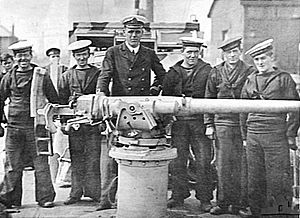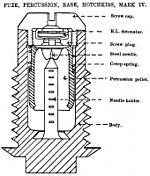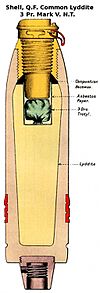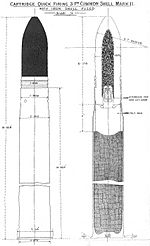QF 3-pounder Hotchkiss facts for kids
Quick facts for kids Hotchkiss 47 mm L/40 M1885& QF 3-pounder |
|
|---|---|

A Royal Navy 3-pounder gun on a central pivot mount in 1915.
|
|
| Type | Naval gun Anti-aircraft gun Coastal artillery |
| Place of origin | France |
| Service history | |
| In service | 1886–1950s |
| Used by | See users section |
| Wars | See wars section |
| Production history | |
| Designer | Hotchkiss |
| Designed | 1885 |
| Manufacturer | Hotchkiss et Cie |
| Produced | 1886 |
| No. built | 2,950 (UK) |
| Variants | 32 to 50 calibers in length |
| Specifications | |
| Mass | 240 kg (530 lb) |
| Length | 2 m (6 ft 7 in) |
| Barrel length | 1.8 m (5 ft 11 in) 40 caliber |
|
|
|
| Shell | Fixed QF 47 × 376 mm R Complete: 3 kg (6.6 lb) Projectile: 1.5 kg (3.3 lb) |
| Calibre | 47 mm (1.9 in) |
| Breech | Vertical sliding-wedge |
| Elevation | Dependent on mount |
| Rate of fire | 30 rpm |
| Muzzle velocity | 571 m/s (1,870 ft/s) |
| Maximum firing range | 5.9 km (3.7 mi) at +20° 4.5 km (2.8 mi) at +80° |
The QF 3-pounder Hotchkiss was a type of light naval gun. It was 47 mm (about 1.8 inches) in size. These guns were first used in 1886. They were made to protect large ships from smaller, faster boats like torpedo boats. Later, they were also used against submarines.
Many different versions of this gun were made. Some were built under special agreements (licenses) in other countries. The most common version was 40 calibers long. These guns were used by many navies around the world. Sometimes, both sides in a war used them! They were also used on land to defend coasts and later as anti-aircraft guns to shoot down planes.
Contents
How the Hotchkiss Gun Was Used
| Hotchkiss 47 mm L/50 M1902 | |
|---|---|
| Type | Naval gun |
| Place of origin | France |
| Service history | |
| Used by | France |
| Wars | World War I |
| Production history | |
| Designer | Hotchkiss et Cie |
| Designed | 1902 |
| Manufacturer | Hotchkiss et Cie |
| Produced | 1902 |
| Specifications | |
| Mass | 594 kg (1,310 lb) |
| Length | 2.85 m (9 ft 4 in) |
| Barrel length | 2.35 m (7 ft 9 in) 50 caliber |
|
|
|
| Shell | Complete: 4 kg (8.8 lb) Projectile: 2 kg (4.4 lb) |
| Caliber | 47 mm (1.9 in) |
| Breech | Vertical sliding wedge |
| Rate of fire | 25 rpm |
| Muzzle velocity | 690 m/s (2,300 ft/s) |
The French Navy used two main types of the Hotchkiss 3-pounder. One was the M1885, which had a shorter barrel (40-caliber). The other was the M1902, with a longer barrel (50-caliber). The longer barrel meant the M1902 could shoot shells faster and farther.
The French M1885 gun was very similar to the British QF 3-pounder. These guns were mostly used to defend large ships like armored cruisers and battleships from fast torpedo boats. During World War I, their job changed. They were then used to try and shoot down enemy aircraft. However, they were not very good at this new role.
After World War I, most of these 3-pounder guns were replaced. Newer, more effective anti-aircraft guns took their place.
Australian Military Use
An Australian 3-pounder Hotchkiss gun was used in a battle near Berbera in 1940. This battle led to Australia's first prisoners of World War II. Today, these guns are used for special ceremonies. They are part of a saluting gun battery at the Garden Island Naval Base.
| Skoda 47mm SFK L/33 H | |
|---|---|
| Type | Naval gun |
| Place of origin | France |
| Service history | |
| Used by | |
| Wars | World War I |
| Production history | |
| Designer | Hotchkiss et Cie |
| Designed | 1890 |
| Manufacturer | Skoda |
| Produced | 1890 |
| Specifications | |
| Mass | Gun: 133 kg (293 lb) Gun & Mount: 530 kg (1,170 lb) |
| Length | 1.55 m (5 ft 1 in) 33 caliber |
|
|
|
| Shell | Projectile: 1.1 kg (2.4 lb) |
| Caliber | 47 mm (1.9 in) |
| Breech | Vertical sliding wedge |
| Elevation | -15° to +20° |
| Traverse | 360° |
| Rate of fire | 25 rpm |
| Muzzle velocity | 560 m/s (1,800 ft/s) |
| Maximum firing range | 3 km (1.9 mi) |
| Skoda 47mm SFK L/44 S | |
|---|---|
| Type | Naval gun |
| Place of origin | France |
| Service history | |
| Used by | |
| Wars | World War I |
| Production history | |
| Designer | Hotchkiss et Cie |
| Designed | 1897 |
| Manufacturer | Skoda |
| Produced | 1897 |
| Specifications | |
| Mass | Gun: 256 kg (564 lb) Gun & Mount: 790 kg (1,740 lb) |
| Length | 2.048 m (6 ft 8.6 in) 44 caliber |
|
|
|
| Shell | Projectile: 1.53 kg (3.4 lb) |
| Caliber | 47 mm (1.9 in) |
| Breech | Vertical sliding wedge |
| Elevation | -10° to +20° |
| Traverse | 360° |
| Rate of fire | 25 rpm |
| Muzzle velocity | 710 m/s (2,300 ft/s) |
| Maximum firing range | 4 km (2.5 mi) |
The Austro-Hungarian Navy also used two types of Hotchkiss 3-pounders. These were made by Skoda under license. The first was the shorter SFK L/33 H from 1890. The second was the longer SFK L/44 S from 1897.
These guns were very important for defending ships against torpedo boats. During the Battle of Antivari in 1914, both sides had Hotchkiss guns. The Austro-Hungarian ship SMS Zenta was sunk by a combined British and French force.
China started using the Hotchkiss 3-pounder in the 1880s. They put them on their cruisers and smaller support ships. During the First Sino-Japanese war, both Chinese and Japanese ships used these guns.
Italy also adopted the Hotchkiss 3-pounder in the 1880s. They used them on their battleships, cruisers, and torpedo boats. In the Italo-Turkish war, ships from both Italy and the Ottoman Empire had 3-pounder guns.
| Hotchkiss 2½ Pounder Yamanouchi Mk I |
|
|---|---|
| Type | Naval gun |
| Place of origin | France |
| Service history | |
| Used by | |
| Wars | Russo-Japanese War |
| Production history | |
| Designer | Hotchkiss et Cie |
| Designed | 1894 |
| Manufacturer | Elswick Ordnance Company |
| Produced | 1894 |
| No. built | 253 |
| Variants | Elswick: Mk I, Mk II, Mk III Yamanouchi: Mk I |
| Specifications | |
| Mass | 127 kg (280 lb) |
| Length | 1.55 m (5 ft 1 in) |
| Barrel length | 1.4 m (4 ft 7 in) 30 caliber |
|
|
|
| Shell | Fixed QF 47 × 131R Projectile: 1.12 kg (2.5 lb) |
| Caliber | 47 mm (1.9 in) |
| Breech | Vertical sliding wedge |
| Muzzle velocity | 432 m/s (1,420 ft/s) |
Japan first used a Hotchkiss 3-pounder with five barrels, like a revolver. Later, they used a simpler single-barrel quick-firing gun. The Japanese versions were called Yamanouchi guns. They were very similar to the British ones.
During the Russo-Japanese War, both sides used these guns. However, the Japanese found them not very effective. They removed them from their main warships after the war.
Polish Military Use
Polish 47 mm Hotchkiss guns, called the wz.1885, were used on the first ships of the Polish Navy. These ships were received after World War I. By World War II, most had been replaced on naval ships. However, some stored guns were used on land. They were set up on temporary mounts by coastal defense units during the Battle of Kępa Oksywska in September 1939.
The Romanian Navy used the Skoda-made version of the gun. These guns were used as secondary weapons on Romanian monitor ships. They were also the main weapons on a class of armored boats. Each of these 8 boats carried one Hotchkiss gun.
| 47 mm L/43 Hotchkiss | |
|---|---|
| Type | Naval gun |
| Place of origin | France |
| Service history | |
| Used by | |
| Wars | Russo-Japanese War World War I Russian Civil War |
| Production history | |
| Designer | Hotchkiss et Cie |
| Designed | 1883 |
| Manufacturer | Obukhov State Plant |
| Produced | 1888 |
| Specifications | |
| Mass | Gun: 235 kg (518 lb) |
| Length | 2 m (6 ft 7 in) |
| Barrel length | 1.5 m (4 ft 11 in) 43 caliber |
|
|
|
| Shell | Projectile: 1.53 kg (3.4 lb) |
| Caliber | 47 mm (1.9 in) |
| Breech | Vertical sliding wedge |
| Elevation | -23° to +25° |
| Traverse | 360° |
| Rate of fire | 25 rpm |
| Muzzle velocity | 701 m/s (2,300 ft/s) |
| Maximum firing range | 4.5 km (2.8 mi) at 10° |
Russia also started with the 5-barrel Hotchkiss gun in the 1880s. Later, they used the simpler single-barrel 43-caliber gun. In 1888, a Russian version began to be made under license.
During the Russo-Japanese War, these guns were used by both sides. However, they were not very good against Japanese torpedo boats. So, they were removed from the main warships after the war. By 1917, at least 62 of these guns were changed to be used as anti-aircraft guns.
In 1886, the Royal Navy adopted this gun. It was called the Ordnance QF 3 pounder Hotchkiss. It was the first modern Quick-firing (QF) artillery gun they used. It was built under license by the Elswick Ordnance Company.
By the middle of World War I, this Hotchkiss gun was becoming old. It was slowly replaced by a more powerful gun, the Ordnance QF 3 pounder Vickers. Even so, many were still available in 1939. Because they were easy to find, simple, and light, they stayed in use on smaller ships. Many were even used again on merchant ships during World War II. They were also used for saluting ceremonies and for gunnery practice until the 1950s.
The US Navy used several kinds of 3-pounder guns. These came from different companies. They used both the 5-barrel Hotchkiss revolving cannons and the simpler single-barrel quick-firing guns.
During the Spanish–American War, ships from both sides had Hotchkiss 3-pounders. By 1910, the US Navy started building new battleships. These ships used larger 3-inch (76 mm) guns instead. Even though they were removed from the main warships by World War I, some 3-pounders were still used on patrol boats. A few even served on these ships through World War II.
Ammunition Used with the Gun
The most common types of ammunition for the 3-pounder guns were low-power Steel shells and common lyddite shells. During World War II, more powerful high explosive rounds were made.
|
|
|
|
|
Images for kids
-
A 3-pounder coastal-defense gun at Port Jackson in 1942.
Where You Can Still See These Guns
- The Noonday Gun at Causeway Bay, Hong Kong.
- A gun at the Royal Queensland Yacht Squadron in Manly, Queensland, Australia.
- Two guns on "elastic frame" mounts in the Casemate de l'Aschenbach, Uffheim, Haut-Rhin, France.
- A group of guns used for saluting at Fort Queenscliff, Victoria, Australia.
- Four working guns on the tall ship Libertad. This ship is a training vessel for the Argentine Navy.
- Three guns used for ceremonies at HMS Drake.
- The National Museum of the United States Navy has one on display. It has a brass gun sight from 1910.
Similar Guns from the Same Time
- QF 3 pounder Nordenfelt : A similar gun made by Nordenfelt.
- QF 3 pounder Vickers : A similar gun made by Vickers.
- 5 cm SK L/40 gun : A German gun that had a similar purpose.
Companies That Made These Guns Under License
- Elswick Ordnance Company
- Obukhov State Plant
- Skoda Works
- William Cramp & Sons
Wars Where These Guns Were Used
- First Sino-Japanese War
- Spanish–American War
- Russo-Japanese War
- Italo-Turkish War
- First Balkan War
- Second Balkan War
- World War I
- Winter War
- World War II
Countries That Used These Guns












